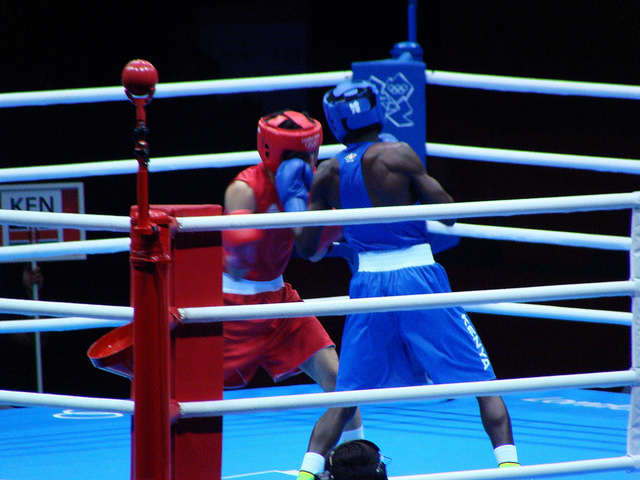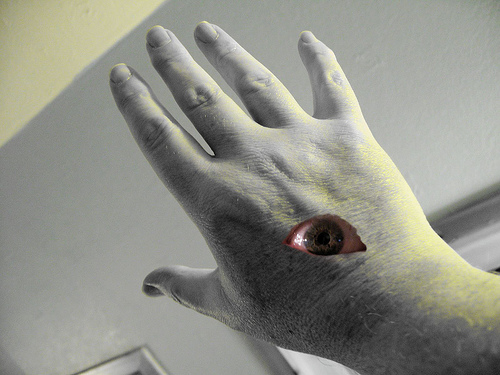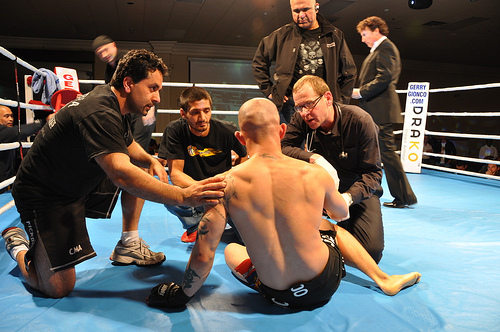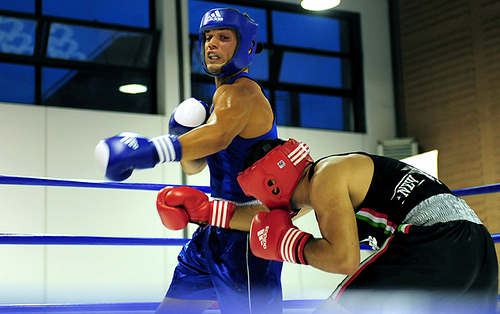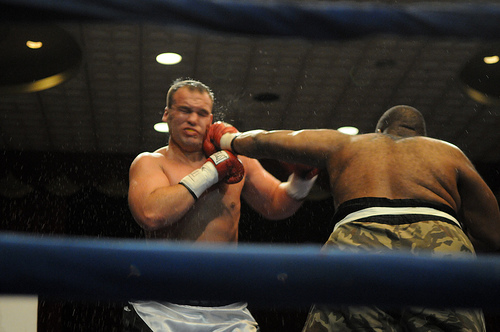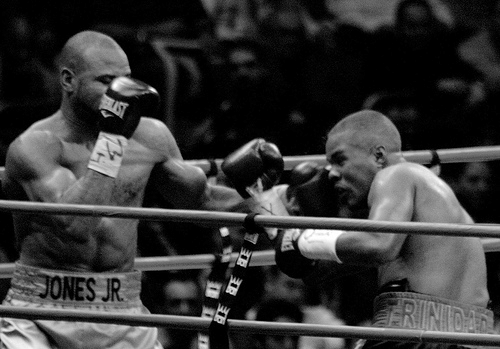For anyone that has ever gone shopping for a heavy bag, the vast selection can be very confusing. You will quickly find that there are a vast array of weights, fills, and coverings.
What is the difference between a 70lb heavy bag and a 100lb heavy bag? Does it matter what kind of fill it has? How about the covering? Is leather better than canvas?
All are valid questions and questions I myself had when I was looking for a bag to hang in my garage. In the end, I seriously asked myself exactly what I was going to use it for and went from there. So you can learn from my experience, here is what I found out.
1. What is the difference between a bag weighing 70lbs vs one a lot heavier, say 100lbs?
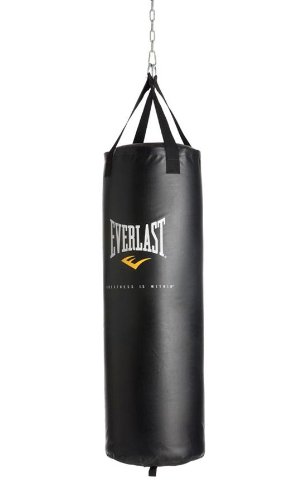
The Heavy Bag
If you ask a sporting goods salesman this question - you'll get a wide variety of answers depending on how knowledgeable he or she is. Most of the ones I talked to had no clue and some even tried to feed me a line of bullshit saying the heavier bags are for pros because they hit a lot harder. In the end, I analyzed what everyone said, cut through the crap, used some common sense and came up with an answer.
Basically - the difference is the amount of resistance the bag is going to give. This is obvious. A heavier bag will put up more of a fight. It will take a lot more force to move it. Not that a swinging bag is bad thing as it ensures you aren't stationary while you are hitting it. The added resistance will be beneficial in the development of stronger punches and more overall power.
I cringe as I type that; however, as power punching is more technique than raw strength. Like weight training, though, you have to continually increase the resistance to experience gains in strength. I believe the same goes for a heavy bag.
I eventually settled on a 100lb bag for my garage. I weigh about 170lb and have a pretty good swing and I find the bag puts up a pretty good fight. It does feel different from the full length 150lb+ bags hanging in my boxing gym though. They move a lot less and I find myself using a more power when I'm hitting them.
But, that brings me to my next point about buying a heavy bag:
2. Does it matter what the heavy bag is filled with?
Absolutely. A 100lb bag filled with cement is going to feel a lot different than one filled with feathers. There are 3 general types of filling and which one is used also helps determine the weight of the bag. First, there is hard fill. It is a shredded fiber fill enclosed in a 1" closed cell foam liner. Second, there are soft fill bags that have slightly more give as they are enclosed in a 2" liner. Third, there are water filled bags which are in a class all their own.
The differences between the types of fill can be measured in the stiffness of the bag, how well it holds its shape, and the effects on your body. A hard fill bag will hold its shape well and is very solid. There will not be much give, so it is going to be the hardest on your body. Your joints and bones will get a workout from this kind of fill.
A soft fill bag, is a lighter version of the hard fill. A little bit of give was introduced to lessen the impact on the bones and joints and make it easier on your hands.
Water filled bags give a unique workout. There is lots of give which makes them easy on your joints, but they also hold their shape. If you think about it, these are most like hitting a human body which is mostly water anyways. Not to mention all the organs splashing around in there...
Which fill you choose is a matter of personal preference and your physical limitations. If you want to really strengthen your bones/joints (or break them), the harder the fill the better. In fact, why don't you forgo the heavy bag and hit brick walls 🙂 No matter which one you choose though, you will still get a great workout.
3. How about the covering - leather or canvas?
You can find nevatear (composite material) heavy bags, canvas bags, and leather bags (of varying qualities of leather). A good quality leather bag will outlast you. It will not tear or crack and will be around long after your hands have shriveled up into little arthritic claws.
Canvas bags are just as good. They will last a long time as well and are extremely durable. I'd tend to stay away from the super cheap vinyl bags. Remember, you are punching and/or kicking this thing. It has to stand up to a bit of a beating or you're going to be wasting some more money on another one in the near future.
4. Other considerations when buying a heavy bag:
The points above are the main considerations, but here are a bunch of others you may want to think about:
Do you have a strong roof or somewhere to hang it?
If not, you may want to consider a free standing bag or a heavy bag stand. They offer the convenience of not having to find a way to anchor a 100lb weight that is going to get the crap kicked out of it everyday from that load bearing rafter in your house. More than one person has knocked the bag off the roof leaving a nasty hole in the ceiling.
You can properly anchor a heavy bag to your ceiling or wall if you have a space for it in your garage or basement. A heavy bag spring placed between the chain and the mount will reduce some of the vibrations and noise that comes with attaching it to your structure.
Do you really care which brand name you are buying?
I hate to say a heavy bag is a heavy bag because there are very good quality bags and then there are shit bags. However, just be careful you are paying for the product and not the brand name on it. Everlast, Ringside, TKO all make excellent bags.
Consider your size...
I weigh 170lb and I work out on both 100lb and 150lb bags. If you weigh 90lbs, will a 100lb bag be of more benefit to you than a 70lb bag? Maybe, maybe not. I'm guessing the added resistance of a bigger heavy bag is not really going to be that big of a deal. You probably get plenty of resistance from a 70lb bag.
Are you buying it online and having it shipped to you?
If so - remember that a filled heavy bag weighs a lot and that increases shipping prices and the overall cost of the bag. Depending on where you order it from - the cost could double. One option is to buy an unfilled bag which will ship at a much more affordable cost.
If you buy one unfilled, you'll need to fill it obviously. Different filler materials have different pros and cons:
- Don't use sand. It compresses and will be like hitting cement. If it ever gets wet it will be hard as rock. You might as well just hit the side of your house.
- Better fills - Rubber mulch inside about 2" of foam, wood pellets, rice, rags pushed in loosely around a pvc pipe filled with sand (for weight), maple peas, dry peas or beans, or water (if you buy one designed for it)
Does it matter if the heavy bag is stitched or has a zipper?
It only matters if you are buying it unfilled. If so - you need an easy way to open it and fill it - thus a zipper is the way to go. If you are buying it already filled - go for the stitching. It will be more durable and there is really no reason to need to get into the bag once it is filled. Even if you do buy one with a zipper - most reputable companies use such a heavy duty zipper that you shouldn't have any problems with it.
Can you hang a bag outside?
Sure - but it will obviously be subjected to the weather. If you live in a humid climate you can expect it to get wet and rot eventually. Same thing if it is subjected to direct sunlight - the leather or canvas will eventually dry out and deteriorate. You can avoid this by treating the leather occasionally or prolong the inevitable by covering it with some type of cover. Ideally, if you want to use it outside - hang it up when you are using it and then put it under cover when you are not.
Can you leave it hanging all the time?
You can, but over time the fill will settle in the bag and your bag will be harder at the bottom than it is at the top. You should occasionally take it down and roll it to even out its contents. If you are taking a prolonged break from training, it's a good idea to take it down and lay it flat.
Heavy bag stand versus mounting
In my opinion the best option is always to mount it - preferably from the ceiling. Doing so gives you the ability to move around it 360 degrees which is beneficial for your footwork, practicing pivots, movement, and so on. That takes room obviously so it's not for everyone. You won't get quite the same range of motion by using a heavy bag stand, but it's better than not hanging one up at all.
Should you buy one with chains or straps on top?
Honestly, it doesn't matter a whole lot as long as they are both heavy duty enough to hold the bag and not break. Chains are often attached to a swivel before being attached to the mount which allows the bag to spin without having to eventually spin back the other way to untangle the straps. Pretty much all of the higher quality bags use chains and they are what I've always used - so I'd recommend them over straps.
How much space do you need to hang a heavy bag?
The ideal amount of space around the bag is enough that you can have the bag swing back and forth and still be able to move around it at a distance just out of punching range. What that ideal amount of space is is going to vary depending on how high your ceiling is. A longer chain is going to require more distance because the bag can swing in a wider arc.
WHAT DO I RECOMMEND
Of all the heavy bags I've tried - the Aqua Punching Bag stands out far above the crowd (use discount code Commando at checkout for 10% off). You can read my full Aqua Punching Bag review to find out why.
In conclusion:
Take a good, hard look at what you are actually going to be using the bag for and how often you are going to use it, before wasting your money on a top of the line model. For myself, I needed a bag that I could hang in my garage and use when I couldn't make it to the boxing gym - I have a wife and 2 kids, so even though I'd love to hang out at the gym 7 days a week, my family is never too thrilled about it. However, if I am in the garage, they feel so much closer. I currently have an Aqua Punching Bag and a regular 100lb heavy bag hanging in my garage and they are working perfectly for the perfectly for the job I had in mind for them.
Ideally, find different weighted bags and try them out. Most sports stores have them hanging up. If not, stop by a boxing gym and try them out there. You will quickly find out the differences in "feel". When you hit it and find it is moving too much or has too much give, then maybe you need a heavier bag. It's all quite a personal decision.
If you're looking for a good dealer, check out the Commando Boxing Store with a huge selection at discount prices. Feel free to comment on this article and add your thoughts, especially if you disagree with something I've written...


